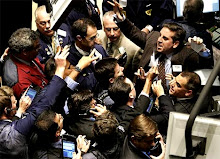The Federal Reserve is taking steps to fine-tune a strategy to reel in some of the unprecedented amount of money that's been pumped into the economy during the financial crisis.
The Federal Reserve Bank of New York said Monday that investors and others shouldn't read anything about the timing of when the central bank will need to reverse course and start boosting interest rates and removing other supports to fend off inflation.
The upcoming operations will involve so-called reverse repurchase agreements. That's when the Fed sells securities from its portfolio with an agreement to buy them back later.
Reverse repos are one of the tools the Fed can use to drain some of the money it has plowed into the economy to ease financial troubles.
The operations will be "extremely small" and won't affect the Fed's key interest rate, officials said. They wouldn't say what the dollar amount for the operations would total.
Fed officials also said they didn't know when the first operation would be conducted and how many there would be. The operations will be conducted to "to ensure operational readiness" at the Federal Reserve, the New York Fed said.
They do not "represent any change in the stance of monetary policy, and no inference should be drawn about the timing of any change in the stance of monetary policy in the future," the New York Fed said.
Reverse repos have been in the Fed's toolkit for years as a way to mop up money in the economy, and most recently were used in December 2008, the Fed said.
This time around, though, the Fed is considering selling its securities to a broader set of investors -- beyond the traditional big "primary" securities dealers such as Banc of America Securities, Citigroup Global Markets and JPMorgan Securities.
Fed Chairman Ben Bernanke has said such large-scale reverse repurchase agreements can be done with banks, Fannie Mae and Freddie Mac and other institutions. Some analysts have said that might involve transactions with money market mutual funds.
To foster the recovery, the Fed earlier this month decided to leave a key bank lending rate at a record low near zero, and pledged to hold it there for an "extended period." Many economists predict rates will stay at super-low levels through the rest of this year and into part of next year.
The central bank's balance sheet has ballooned to over $2 trillion -- reflecting the special programs it has set up to spur lending, stabilize banks and revive the economy. That's more than double the amount from before the financial crisis struck.
One of the biggest challenges for the Fed is deciding exactly when to start boosting rates, and when to remove economic and financial supports.
Remove the supports too soon and the recovery could be derailed. Leave the supports in place for too long risks unleashing inflation.
From Yahoo Finance
Monday, November 30, 2009
Subscribe to:
Post Comments (Atom)


No comments:
Post a Comment